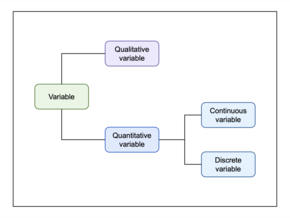Continuous or discrete variable
| Part of a series on statistics |
| Probability theory |
|---|
 |
In mathematics and statistics, a quantitative variable may be continuous or discrete if they are typically obtained by measuring or counting, respectively.[1] If it can take on two particular real values such that it can also take on all real values between them (including values that are arbitrarily or infinitesimally close together), the variable is continuous in that interval.[2] If it can take on a value such that there is a non-infinitesimal gap on each side of it containing no values that the variable can take on, then it is discrete around that value.[3] In some contexts a variable can be discrete in some ranges of the number line and continuous in others.

Continuous variable
A continuous variable is a variable whose value is obtained by measuring, i.e., one which can take on an uncountable set of values.
For example, a variable over a non-empty range of the real numbers is continuous, if it can take on any value in that range. The reason is that any range of real numbers between and with is uncountable, with infinitely many values within the range.[4]
Methods of
In statistical theory, the probability distributions of continuous variables can be expressed in terms of probability density functions.[6]
In

Discrete variable
In contrast, a variable is a discrete variable if and only if there exists a one-to-one correspondence between this variable and , the set of
Methods of calculus do not readily lend themselves to problems involving discrete variables. Especially in multivariable calculus, many models rely on the assumption of continuity.[10] Examples of problems involving discrete variables include integer programming.
In statistics, the probability distributions of discrete variables can be expressed in terms of probability mass functions.[6]
In
In
Mixture of continuous and discrete variables
A mixed multivariate model can contain both discrete and continuous variables. For instance, a simple mixed multivariate model could have a discrete variable , which only takes on values 0 or 1, and a continuous variable .[14] An example of a mixed model could be a research study on the risk of psychological disorders based on one binary measure of psychiatric symptoms and one continuous measure of cognitive performance.[15] Mixed models may also involve a single variable that is discrete over some range of the number line and continuous at another range.
In probability theory and statistics, the probability distribution of a mixed random variable consists of both discrete and continuous components. A mixed random variable does not have a cumulative distribution function that is discrete or everywhere-continuous. An example of a mixed type random variable is the probability of wait time in a queue. The likelihood of a customer experiencing a zero wait time is discrete, while non-zero wait times are evaluated on a continuous time scale.[16]
See also
- Continuous or discrete spectrum
- Continuous function
- Count data
- Discrete mathematics
- Continuous spectrum
- Discrete spectrum
- Discrete time and continuous time
- Continuous-time stochastic process
- Discrete-time stochastic process
- Continuous modelling
- Discrete modelling
- Continuous geometry
- Discrete geometry
- Continuous series representation
- Discrete series representation
- Discretization
- Interpolation
- Discrete measure
- Discrete space
References
- PMC 5037948.
- PMID 30775310.
- ^ K.D. Joshi, Foundations of Discrete Mathematics, 1989, New Age International Limited, [1], page 7.
- .
- OCLC 236082842.
- ^ ISSN 1431-875X.
- .
- ISBN 978-0444894830.
- ISBN 978-0-444-86580-9.
- ISBN 978-1-4613-0893-5.
- ISBN 978-3319760285.
- .
- ISBN 0803951280.
- .
- doi:10.2307/2533101.
- doi:10.2307/3212413.






